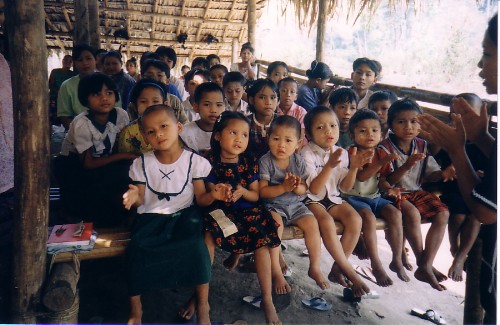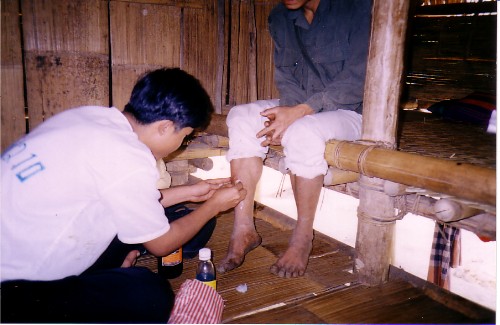|


Some background information regarding the IDP situation is vital tounderstanding the amount of help these mission trips provide. Thesepeople have been living in fear of the Burma Army (BA) since 1997, whenthe BA forced many villagers to relocate. The IDP living situation isone of survival, hiding and when necessary, fleeing. The hiding sitesare deep in the jungle on mountainsides and sometimes in valleys. Forsecurity reasons, very few families live in one hiding site and theyrarely live in one place for more than one year. In fact, according tosecurity and people based in these hiding sites, IDPs often move atleast once or twice a year. Some hiding sites are near the Burma Armycommunication and supply routes and are quite a distance from oneanother; from at least half a day to two days walk.
IDPs living in these hiding sites earn their living with slash and burnrice cultivation methods. Some IDPs make a small income from collectinghoney, hunting and selling goods in neighboring countries. With thisincome they buy food and other daily necessities for their families. Aregular income does not exist for these families. Every family memberhas to work in order to get enough food for their families to survive.Even elderly people must work. This year, due to abnormal weather andinsects, a number of families did not harvest enough rice to last thewhole year. House utilities, such as pots, plates, blankets and warmcloths are very sparse.
Many children in the hiding sites that the mission team visited are notable to go to school. This is because their hiding sites are far awayfrom one another. And in order for their families to survive, evenchildren have to work and help their parents provide food.
There are no security guarantees for IDPs in these hiding places. TheKaren National Union (KNU) and the Karen National Liberation Army(KNLA) leaders in the area assist them whenever possible. For securitythey prepare and keep their rice paddy and some households in secretplaces. However, the rice paddy they hide is sometimes destroyed byrats, wild animals or fire.
The purpose of this trip was to encourage the Internally Displaced Persons (IDPs) spiritually, provide health care services and to understand the IDP situation. The team went on the mission trip from March 3, 2005 to April 1, 2005.
This mission consisted of a number of trips to various IDP hiding places. The team visited and encouraged IDP families, as well as provided health care services to those in need. Medicine was left at some sites for future use. At night, there were worship services and concerts presented to the IDP groups and communion was served at a number of sites. Team members would travel from house to house showering prayer on the IDP families. The team was blocked from crossing a river at one point by heavy gun fire by the Burma Army as well as Burma Army troop activity at the river crossing point.
The Mission team received medicine arranged by the District chairman. The mission team’s medic provided medical treatment to 214 IDP patients. The team responded as best it could to whatever needs were encountered. It was difficult to get medicine to distant sites, but they left some medicine behind for the people staying in those sites.
In some mission areas the IDP’s are animist or Buddhist but most of the IDPs visited on this mission were Christians. In some of the hiding sites visited by the team, many of IDPs desired to have a church again. They are hiding in these sites without a church pastor, and therefore have little opportunity to hear God’s Word or have guidance from church leaders. Communion services are few and far between. The IDPs try to live and survive daily, while hoping to receive peace and assistance from outside sources. When the mission team arrived at their hiding sites, the IDPs welcomed them and received them with whatever they had, as well as inviting them to visit at least once a year.
By the grace of God, the relief mission was successfully completed. The relief team hopes that this kind of mission trip can be done in the future in order to encourage IDPs spiritually and treat the physical needs of many. The team arrived safely back from the mission.
ENDS
